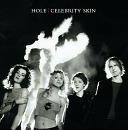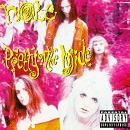
Hole's Celebrity Skin:
A Review
by

Celebrity Skin
Hole. Celebrity Skin. DGCD-25164.
Many long-time fans and critics of Hole have criticized Celebrity Skin
(1998) for being too "soft" and radio-friendly. In fact, one of
the most publicized disapproving voices has arisen from the band itself.
Drummer Patty Schemel--who has been replaced by Samantha Malone for the
band's Celebrity Skin tour--told Philip Weiss of Spin: "[Celebrity
Skin] is not my masterpiece, and what the band has become I don't want
to be a part of any more." Joining Schemel on Celebrity Skin are lead
vocalist and rhythm guitarist Courtney Love, lead guitarist Eric Erlandson,
and bassist Melissa Auf der Maur (who replaces Kristen Pfaff). In addition
to the band members, Billy Corgan of the Smashing Pumpkins has co-written
five songs on Celebrity Skin. Certainly, Schemel's departure from Hole should
concern fans. Schemel has co-written songs with band-mates Love and Erlandson
since Live Through This (1994); the visible physicality of her drumming
has added a dynamic element to Hole's live performances; and she was integral
to the band's pre-Celebrity Skin, rougher, tougher, radio un-friendly
sound that gained a loyal following of moshers and Generation X punks.
Apart from Schemel's disappointment with Celebrity Skin, there have been other criticisms, much of which have focused on Love's recently acquired celebrity status and the effects this change has had on the band and their music. While I would agree that Hole is attempting to reach a more mainstream, pop-oriented audience with the radio-friendly Celebrity Skin, I disagree with those assessments of the band as "selling out." Hole's social commentary is as sharp as it has been on earlier band releases; however, the targets of Hole's critiques have shifted from riot grrrls, beauty queens, hippie parents, and Seattle grunge rockers to Hollywood star-makers, the marketing of rock `n' roll, and the shallowness of mainstream pop music and show-business celebrities.
Certainly, Celebrity Skin--which was produced by Michael Beinhorn--sounds much different from Hole's days as one of the premier bands on the independent Caroline Records label. Hole's debut CD, Pretty on the Inside, was put out by Caroline in 1991, as the band was gaining a fairly solid core of supporters in the underground music scene. In 1994, David Geffen's DGC picked up the band, and Hole released Live Through This, a CD that brought them some mainstream success with "Violet," "Miss World," and the MTV-favorite "Doll Parts." In 1995, Caroline released Ask For It, an EP-length compilation that includes previously unreleased versions of "Violet" and "Doll Parts," as well as covers of the Velvet Underground's "Pale Blue Eyes" and a brief, eardrum-shredding medley of the Germs' "Forming" and Beat Happening's "Hot Chocolate Boy" ("Forming/Hot Chocolate Boy").

Pretty on the Inside
"Celebrity Skin," the first cut on the CD of the same name, yields a more mellow-sounding Hole. Erlandson's guitar-playing is cleaner than what we find on the grunge/punk-infused "Pretty on the Inside" (Pretty on the Inside) or "Gutless" (Live Through This); Auf der Mar's bass is more controlled than Pfaff's relentless thumping on "Rock Star" (Live Through This); Schemel's drumming, while still solid and powerful, is also more restrained here than on previous releases; and, perhaps most striking, Love's voice is much more polished than the raw-throated screaming of the earlier Hole. Many of the CD's songs begin very innocuously, fooling us into thinking Hole produces nice ear candy. The real "bite" usually comes later, after we've been seduced by the catchiness of a tune; seemingly out of nowhere, we may be suddenly confronted by a violent image, a distorted riff that's not quite so hummable, a cynical sneer, or a scream. The power of the songs comes from these disruptive lyrical and musical moments that disorient us, shaking us out of our complacency.
"Celebrity Skin," for example, begins with a nice power chord riff and some rather subdued vocals: "Oh, make me over / I'm all I want to be." The next lines, however, undermine the view of a woman making herself beautiful in the conventional sense: "A walking study / In demonology." What we have here is not a woman mindlessly and happily making herself beautiful for her adoring public, but someone demonized by a mainstream pop culture that, at least for now, embraces her as one of their own. One minute she's heralded as "beautiful garbage," a "slut" who provides onlookers with a titillating sideshow, and the next minute she's "a star." The "Teenage Whore" of Pretty on the Inside and the loud, obnoxious, filthy-mouthed "pee girl" of "Softer, Softest" (Live Through This) is now Hollywood's Versace-clad "Cinderella."
Refusing to be victimized, however, she makes it clear that she is the one responsible for this transformation from human garbage to Cinderella pop star. She has remade her body, her music, and her image; indeed, she has become one of Tinseltown's most intriguing residents. This celebrity status brings with it a new credibility, and she uses her new position to drive home a scathing critique of the clique she has fooled into accepting her. Now part of the "in" crowd, she demystifies celebrity, telling all of her so-called "friends" to go to hell. Strip away all of that gorgeous "celebrity skin," and you'll discover that Hollywood celebrities are no better than trailer trash. Reminiscent of her pre-Celebrity Skin persona, Love growls in "Malibu": "And I knew / Love would tear you apart / Oh and I knew / The darkest secrets of your heart." It is Courtney Love and Hole "tear[ing] apart" the respectable beach community by exposing those "darkest secrets." All it takes is some plastic surgery, a good P. R. person, and some glamour posturing to "fit right in," and this becomes Love's frenetic new mantra in "Reasons to be Beautiful": "Miles and miles of perfect skin / I swear I do, I fit right in." Playing off of these lines, she continues, "Miles and miles of perfect sin / I swear, I said, I fit right in / I fit right in your perfect skin." Regardless of how often she repeats the words, however, she finds this new role oppressive. "I cannot breathe" affirms the mantra's hollowness.
Of course, the members of Hole are no strangers to the fatalities of celebrity. Love's husband, Kurt Cobain, unsuccessful at his attempts to reconcile his art with his rising celebrity status, committed suicide shortly after Hole released the appropriately titled Live Through This; a few months later, Hole's then bassist, Kristen Pfaff, died as a result of a heroin overdose. Celebrity Skin attests to a positive strength that grows from anger at celebrity and those who succumb to its death grip, as well as the sorrow that accompanies human loss. In "Northern Star," Love's gravel-tinged voice reappears, but this time it's backed by acoustic guitars, strings, and a rumbling kettle drum. Emotions linger close to the surface--eternal loneliness and rage at the one who has allowed himself to self-destruct. "No loneliness, no misery is worth you / Oh tear his heart out cold as ice it's mine." This elegy attests to the psychological and emotional aftermath of loss and destruction and is reminiscent of tracks on Patti Smith's Gone Again (1996), which was also written in the throes of mourning. Like Smith, Love emerges stronger and is optimistic about the future. In the upbeat, bubble-gummy "Heaven Tonight," a less cynical Love sings, "I can't believe that I could be happy / summer will come again / I can be happy." Even though there will be moments of grief, anger, and depression, happiness is possible, and it's that possibility that makes life worth living.
On one level, Celebrity Skin attests to the emotional maturity of the band. A top-fortyish, upbeat song like "Heaven Tonight," for example, seems at odds with Hole's pre-Celebrity Skin penchant for fast, distortion-imbued explosions of raw emotion. Celebrity Skin's cover--depicting the band standing in front of burning palm trees in Malibu--represents the band's emergence from the ashes of personal and professional losses. Previous CD covers and liner notes have depicted bodies in various states of physical distress: mutilated bodies, make-up caked beauty queens, and dismembered dolls. The cover of Ask for It, which appears chronologically between Live Through This and Celebrity Skin, pictures a woman's hands, palms up, against bathroom tile. In an effort to alleviate her pain, she has slashed her wrists in a desperate suicidal act. Notably, though, the suicide has failed, and her wounds are in the process of healing: the skin is beginning to close, and heavy scar tissue is beginning to form. With Celebrity Skin, bodies are healed, toned, and made over. Standing in front of the burning trees, the band strikes their best celebrity pose. Although the burning palm trees are in the background, the fire still has the power to destroy those who get too close to it.


Live Through This and Ask For It
Celebrity Skin contains dichotomous imagery of fire and water, which have the power to cleanse but also the power to kill. Dedicated to "all the stolen water of Los Angeles and to anyone who ever drowned," Celebrity Skin drives home this allusion to the turn-of-the-century water rights case--when greedy Los Angeles "stole" water from the Owens Valley--by including a picture of Los Angeles's Department of Water and Power in the liner notes. As homage to Los Angeles, Celebrity Skin constitutes a powerful critique of the city's celebrity subculture, which "steals" the souls of its would-be stars. "Use Once and Destroy" sums up the physical, emotional, and spiritual toll wrought by the celebrity machine: "Take your rapture blister burns / Stand in line it's not your turn." Now it's Hole's turn to shake up a new audience of pop music fans who have been numbed intellectually by the predictability of artists like Celine Dion and Mariah Carey. Celebrity Skin should give top-forty radio a much-needed adrenaline jolt.